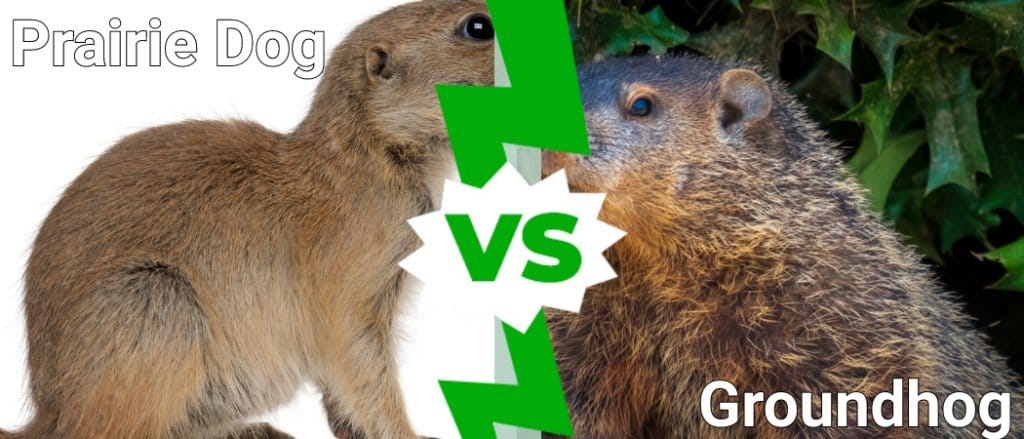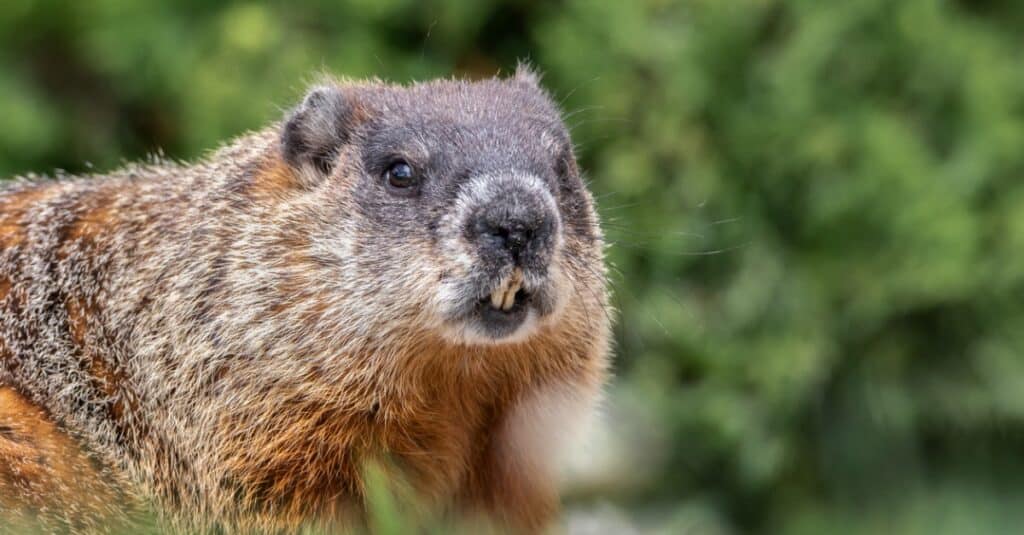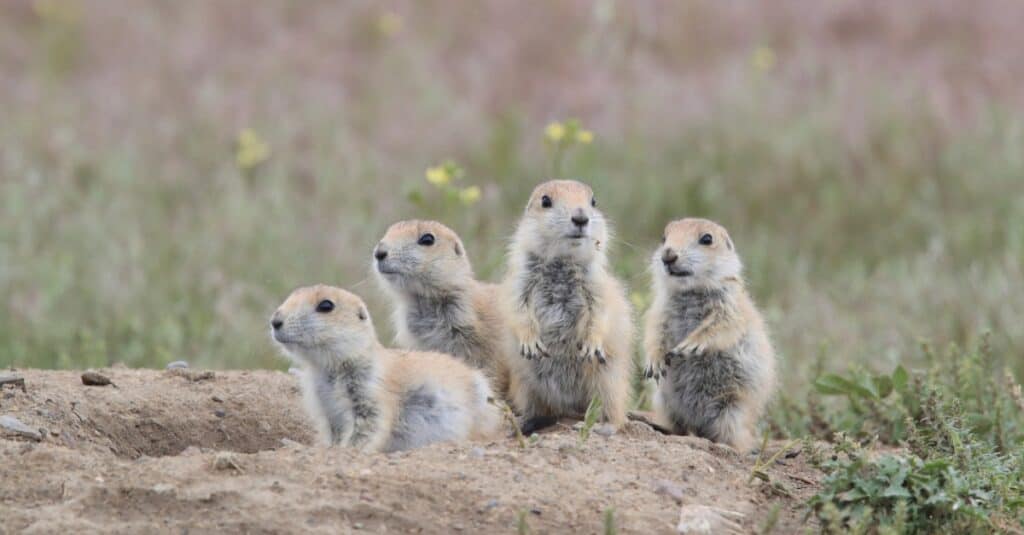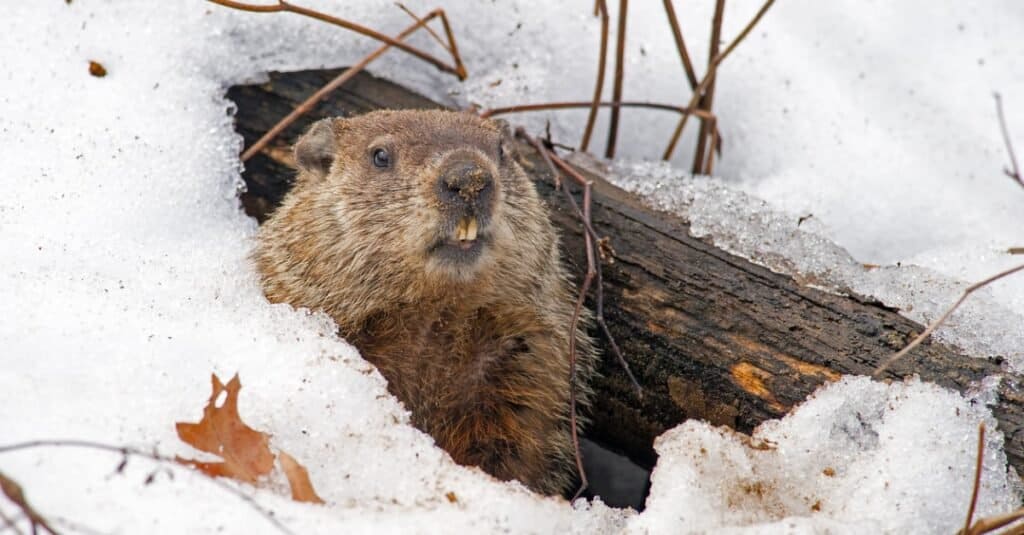Prairie dogs and groundhogs are incredibly similar animals, often so much so that people may think they are different names for the same creature! While that isn’t the case, it’s easy to see how it can happen. While they may look similar and even related, there are a few key differences that can help us understand how a prairie dog and a groundhog are actually different. Let’s explore those differences!
Comparing a prairie dog and a groundhog

| Prairie dog | Groundhog | |
| Size | Weight: 1-4l bs Length: 12-16 in | Weight: 10 to 13 lbs Length: 2 feet |
| Color | Brown, grey, black, white, tan | Brown, grey |
| Burrows and Colonies | Large expanses of connected burrows, live in colonies of up to 100 individuals | Small burrows with immediate family unit, most solitary of all marmots |
| Range | Western United States, mostly across the plains and valleys | Eastern United States and across most of Canada |
| Evolution and Naming | Rodent belonging to the Marmotini tribe, ground squirrels | Rodent belonging to the Marmotini tribe, second largest of the marmots |
Key Differences Between Prairie Dog vs Groundhog
The main differences between a prairie dog and a groundhog lie in their size, their range, and their social structure. Let’s explore the main differences quickly, then take a deep dive into all of the other differences between them.
The most obvious difference between a prairie dog and a groundhog is their size. Prairie dogs are much smaller than groundhogs, sometimes by as much as 2-3x. Groundhogs are the second largest species of marmots, while prairie dogs are much lower on the list. Aside from size, you can usually identify them from the region you see them. Prairie dogs are found in the western United States in the Great Plains, meadows, and fields. Groundhogs are found in the eastern United States and Canada, usually in fields and meadows near a tree line. Finally, prairie dogs are much more social than groundhogs, often having colonies of up to 100 individuals. Groundhogs are much less social and more solitary animals.
Prairie Dog Vs Groundhog: Size

Groundhogs are much bigger than prairie dogs.
©iStock.com/Jean Landry
Prairie dogs are rather small, much smaller than their groundhog cousins. On average, they weigh between 1-4 lbs and measure up to 12-16 inches long. They are considered rodents, and many people would easily identify them as such, primarily because of their size.
Groundhogs, on the other hand, are much larger than prairie dogs. They generally weigh between 10-13 lbs and measure up to 2 feet long from tail to head. Both prairie dogs and groundhogs are in the marmot family, and clearly, there is a lot of variance when it comes to size. Groundhogs are the second largest of the marmots, only being beaten out by their cousin, the hoary marmot.
Prairie Dog Vs Groundhog: Color
There are five species of prairie dog and only one species of groundhog, allowing for a much greater range of colors for the smaller marmots. Prairie dogs can come in variations and colorings that include brown, grey, tan, white, and black. There are a few key species that have distinct colorations:
- black-tailed prairie dogs and Mexican prairie dogs have tan bodies and black tails.
- Gunnison’s prairie dogs have yellowish fur with black hair mixed in, often having darker colors at the tops of their heads, cheeks, and eyebrows.
- other species have white or grey-tipped tails and can have grey coloring.
Groundhogs are generally more standardized in their coloring. They almost always have a grey-brown coat that is much thicker than a prairie dog. Groundhogs have a double insulated coat, allowing them to weather the cold better than their smaller cousins.
Prairie Dog Vs Groundhog: Burrows and Colonies

Some prairie dog colonies have millions of individuals across thousands of miles.
©Frank Fichtmueller/Shutterstock.com
Prairie dogs are some of the most communal animals in the United States. When they dig their burrows as they come of age, they often connect them to the existing burrows of their colony. Most burrows are 3-6 feet below the surface and can span as long as 15 feet. As they begin connecting, burrow systems can span hundreds of feet across and have interconnected points all along the way. Prairie dogs live in colonies, sometimes referred to as “towns” because of their size. In Texas, one prairie dog town stretched 25,096 miles and had an estimated 400 million prairie dog residents.
Groundhogs are also social animals, but they are much less communal. Most groundhogs live in small groups with their immediate family, often made up of only a breeding pair and their offspring. Their burrows are roughly the same size, only they don’t usually connect to other groups of groundhogs. Generally, groundhogs are considered the most solitary of all 15 marmot species, while prairie dogs are some of the most social.
Prairie Dog Vs Groundhog: Range

Prairie dogs live in the western United States, while groundhogs live in Canada and the eastern United States.
©iStock.com/BrianEKushner
When identifying a marmot, location is usually the best first step. Prairie dogs live in the western United States. There are five species of prairie dogs, all living in certain niches across the southwest. They generally prefer fields, meadows, and prairies, hence their name. As long as there is space and food, prairie dogs are likely to be present across their preferred habitat in their range.
Groundhogs are also a widespread marmot species. Their range extends east of the Mississippi, south in Alabama, all the way north into Canada. Only in Canada do groundhogs extend west past the Mississippi. They are lowland marmots, unlike most other species, and are adapted to these environments. Groundhogs prefer fields and meadows that have a treeline nearby.
Prairie Dog Vs Groundhog: Evolution and naming
Prairie dogs and groundhogs are closely related animals. They are both members of the Marmotini tribe, of which there are six separate genera. Marmots are classified as large ground squirrels that are usually found in groups, often hibernating during winter. This is true for both the groundhog and the prairie dog.
The taxonomy between marmots, Marmotini, and Marmota is rather confusing, but it all really points to the same thing: groundhogs and prairie dogs are closely related animals that share a relatively recent genetic ancestor, they have just happened to have adapted to various regions of the world.
The photo featured at the top of this post is © iStock.com/Jon Marshall
Thank you for reading! Have some feedback for us? Contact the AZ Animals editorial team.







